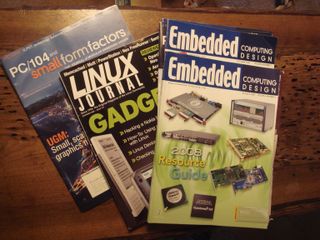Toaster RAID Returns, Better Than Ever
Sources Of Information
I already had the external power supplies in tow that were suitable for the project, but my experience with mini-ITX motherboards was limited and there was a lot I had to learn. I needed to find out about the available motherboards, which firms made and sold them, and where I could buy them locally. Finding a brick-and-mortar vendor in San Mateo or Santa Clara County California seemed preferable to placing an order over the Web with a supplier in some remote or out-of-state location. It was not evident at first what would be the best power supply to obtain and I needed to find that out.
Finding the right motherboard and power supply turned out to be a challenge. There are many small motherboards out there, but many had only one or two SATA interfaces. There were few motherboards with a power supply to match. It took a lot of reading and research to find the right external power supply.
The Magazines
The best magazines to read are "Embedded Computing Design," "PC/104 and Small Form Factors," and "Linux Journal." All the key makers of SBCs advertise and write in these journals. The August 2008 resource guide in "Embedded Computing Design" was especially useful, with in-depth profile write-ups of all the manufacturers, suppliers, and vendors. There are lots of other sources of good information, in print, and on the Web, but the place to start is with these three publications. The articles and advertisers led me to the sources of components needed to make a good Toaster RAID with the right parts.

Hardware Vendor Websites
The magazines revealed good leads for manufacturers, motherboard models, power supplies, and vendors of the pieces needed for a new Toaster RAID. I went to many Web sites to learn more and to study product offerings. The sites I found to be the most informative and useful were:
- Pollywell Computers in South San Francisco is where I finally bought the motherboard, power supply, CPU, and memory for the Toaster RAID that is the subject of this article (www.polywell.com).
- Portwell in Fremont, Calif., markets a large collection of mini-ITX boards (www.portwell.com).
- Jetway Compter in Fremont makes the motherboard that is the subject of this article (www.jetwaycomputer.com).
- AMD's, Intel's, and VIA's Web sites all have mini-ITX product offerings. VIA also makes nano-ITX and pico-ITX boards.
- General Electric Fanuc is a joint venture between GE and Fanuc. It offers a wide variety of industrial SBCs but unfortunately the products did not offer SATA and multiple Gigabit Ethernet ports needed for storage devices, so I once again used a GE toaster. But General Electric Fanuc's site is interesting (www.gefanuc.com).
- Kontron has a wide selection of mini-ITX motherboards (www.kontron.com).
- Mini-box.com sells a nice variety of AMD, Intel, and VIA mini-ITX motherboards and also offers power supplies (www.mini-box.com).
- Mini-ITX.com is a news and information portal about mini-ITX and other small form-factor system motherboards. There is a store on the site that offers mini-ITX boards, power supplies, cases, and other accessories. The information about available power supplies from this site is useful, as well. There is a section about customer case-mod projects using small motherboards, including computers in toasters, cigar boxes, waffle irons, and more (www.mini-itx.com).
- Logic Supply is another mini-ITX specialty supplier. It offers a large variety of motherboards from major manufacturers. It carries the VIA NAS 7800-15LST, which was the only mini-ITX board I could find with eight SATA ports. There is a large collection of external power supplies (www.logicsupply.com).
- Trenton Technology has an interesting offering of PICMG SBCs. None of its products seemed to fit the requirements for RAID 5 in a toaster but the products are interesting and it helped me learn (www.trentontech.com).
- Mobile Computing Solutions and Global American have rich collections of mini-ITX product offerings and accessories (store.mo-co-so.com and http://www.globalamericaninc.com).
While researching this project, I found some sites that were interesting and amusing, but not directly germane to constructing a file server in a toaster. Still, the following sites deserve mention:
Stay on the Cutting Edge
Join the experts who read Tom's Hardware for the inside track on enthusiast PC tech news — and have for over 25 years. We'll send breaking news and in-depth reviews of CPUs, GPUs, AI, maker hardware and more straight to your inbox.
- Somebody faked a story about a toaster bay in a PC. It took a while to discover the hoax.
- There are many articles on case mod projects at mini-ITX.com, including one item on a small desktop in an attractive retro toaster (atwww.mini-itx.com, click the Projects link).
- If PCs Were Toasters offers a light-hearted look at what heavy-hitter technology firms might do with a toaster.
- A networked toaster is used to hack a PC.
- An HP laptop and a toaster have a conversation under a Christmas tree about the joys of being a holiday gift.
-
I thought the idea in fitting a NAS into a toaster is that you plugged the disks through the bread slots!Reply
-
boostercorp ytoledano3I thought the idea in fitting a NAS into a toaster is that you plugged the disks through the bread slots!yeah it would ve been nice if you could just shove in two hot plug & play drives in there.Reply
-
Astara boostercorpyeah it would ve been nice if you could just shove in two hot plug & play drives in there.Imagine a backup-product like the various 'one-touch' backup offerings -- but in this case, you just push a drive into the toaster slot -- it begins the backup process, when done, it can eject** the drive. That sounds very sweet.Reply
**-raise drive, not physically throw it out of the toaster! :-)
-
Shadow703793 ReplyUsing the small 2.5" drives, there is easily room for eight to 12 drives.
Then why not use some of the 640/750GB or 1.5/2TB drives?
Any ways cool mod.
Most Popular

